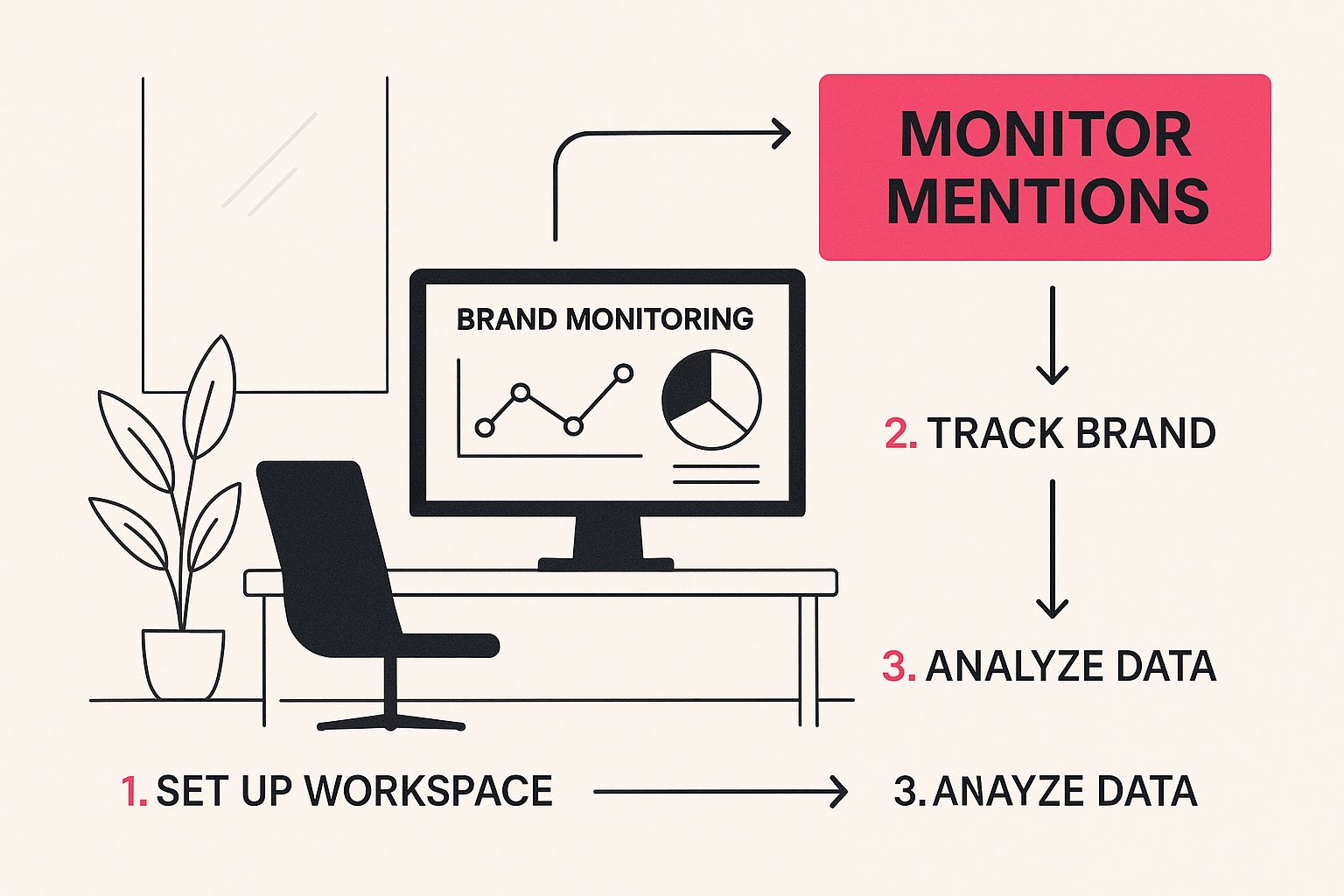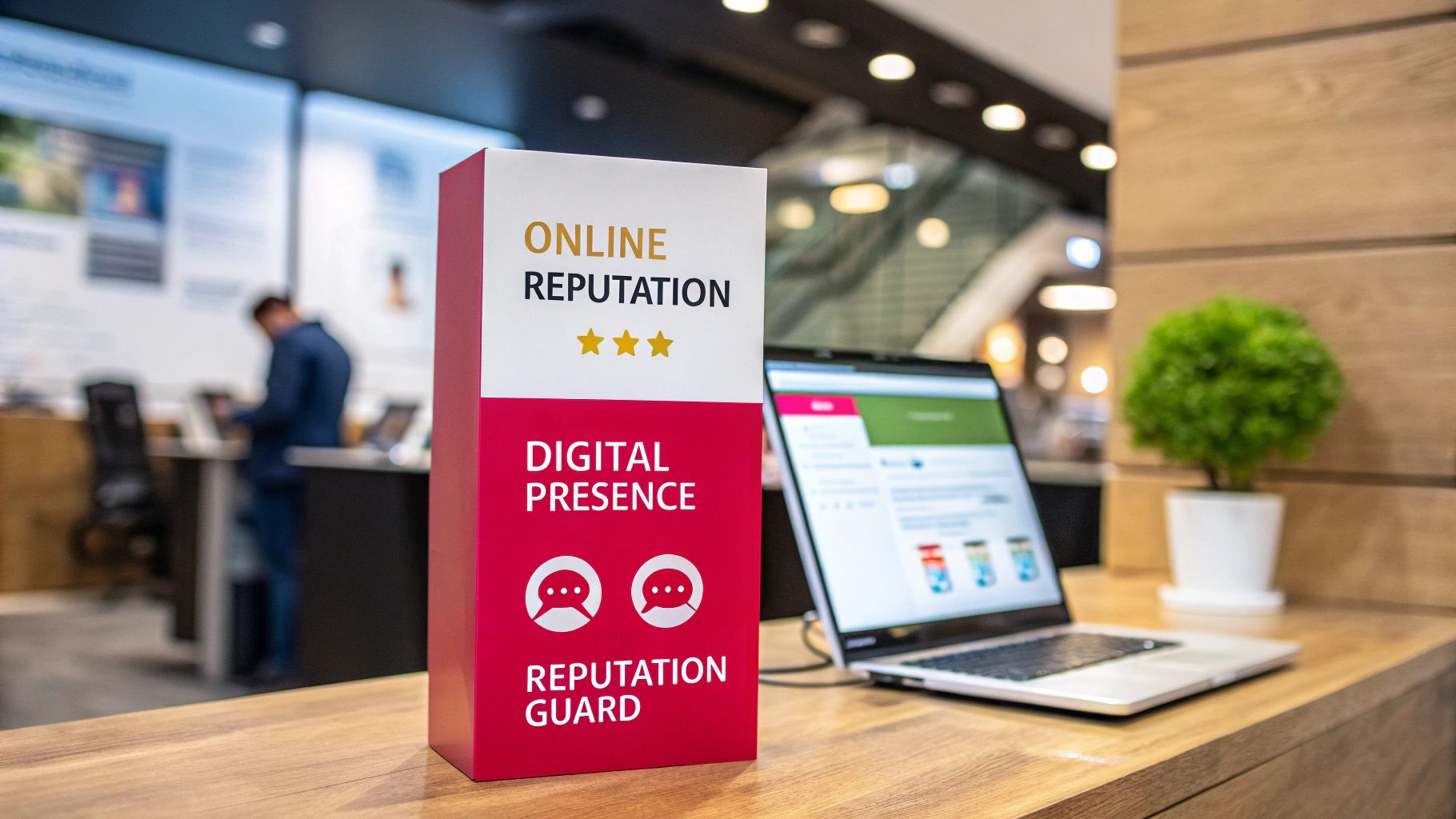Online reputation management (ORM) isn't just about damage control; it's the continuous effort of shaping how the public sees your brand online. It’s about listening to the conversation, participating in it, and making sure the story being told is the one you want people to hear. Think of it as the digital equivalent of maintaining a pristine storefront—it's a core asset that needs constant, strategic care.
Why Online Reputation Management Matters More Than Ever
Picture your business online. Is it a clean, inviting space that builds confidence, or is it messy with unanswered complaints and old news? That online presence is often the very first handshake a potential customer has with your brand, long before they ever think about buying something or talking to a salesperson.
What they find on Google, review sites, and social media creates a powerful first impression. A single bad review or a negative news article can be enough to send a customer straight to your competition. Simply put, your reputation has a direct line to customer trust and, ultimately, your revenue.
The Bedrock of Digital Trust
At its heart, managing your online reputation is all about building and keeping trust. When people see glowing reviews, thoughtful responses to criticism, and genuinely helpful content, it reassures them they’re making the right choice. This isn’t about faking it. It’s about genuinely showing up and proving your commitment to quality and customer care.
A proactive ORM strategy is critical to protecting and enhancing your brand’s image. In a competitive environment where reviews and recommendations carry more weight than ever, a single negative comment can influence potential customers’ choices.
This proactive approach is no longer optional. The online reputation management market is growing rapidly for a reason. In the Middle East and Africa (MEA) region, for instance, revenue from these services is projected to climb significantly by 2032, showing just how seriously businesses are taking their digital image.
A Core Business Function, Not a Marketing Add-On
Good ORM isn't just a task for the marketing department; it's a fundamental part of running a modern business. For anyone just starting to wrap their head around this, understanding why online reputation management is crucial for small businesses is a fantastic primer on why this matters from day one.
So, what does this actually involve? A solid ORM strategy is built on a few key pillars that work together to create a strong, positive presence.
The Pillars of a Strong Digital Reputation
| Pillar | Objective | Example Action |
|---|---|---|
| Monitoring | To listen and understand what's being said about you. | Using tools to track brand mentions on social media, forums, and news sites. |
| Responding | To engage with the community and show you care. | Replying to every Google review—good and bad—within 24 hours. |
| Building | To proactively shape your brand's narrative. | Publishing customer success stories and encouraging happy clients to leave reviews. |
By weaving these activities into your daily operations, you build a reputation that can weather the occasional storm. It’s an ongoing process, and if you need an expert hand to get started, our team can help you manage online reputation with a proven strategy.
The Listen, Act, and Amplify Framework for ORM
An effective online reputation strategy isn't just about putting out fires when things go wrong; it's a proactive, structured system. Think of it as a complete health and wellness plan for your brand, built on three core pillars that work together: Listen, Act, and Amplify. This framework gives you a practical blueprint to take firm control of your brand’s story.
This infographic gives a great visual of what it means to monitor your brand's digital presence, which is the heart of the 'Listen' phase.

As you can see, actively keeping an eye on things through a dashboard is the first step. It's how you gather the intelligence you need to protect and grow your brand's reputation.
Pillar 1: Listen and Gather Intelligence
The first pillar, Listen, is your digital intelligence-gathering operation. It’s all about tuning into the constant stream of conversations happening about your brand, your products, and your industry across the entire web. You simply can't manage what you don't measure.
This stage means actively using tools and processes to track what people are saying. But it's about more than just finding mentions; it’s about understanding the context and the feeling behind them.
Key listening activities include:
- Monitoring Brand Mentions: Set up alerts and use social listening tools to catch every mention of your company name, key products, and executives on social media, forums, and news sites.
- Tracking Customer Reviews: Systematically check review platforms like Google, Trustpilot, and other industry-specific sites to see what customers are sharing about their real-world experiences.
- Analyzing Social Sentiment: Go beyond just counting mentions to analyze the overall tone of the conversation. Is the chatter positive, negative, or neutral? This gives you a crucial health check for your brand.
Pillar 2: Act with Purpose and Speed
Once you’re listening effectively, the next pillar is to Act. This is your response plan. It’s where you take the intelligence you’ve gathered and turn it into meaningful engagement and, when needed, decisive action. Speed and empathy are your greatest allies here.
A slow or tone-deaf response can do more damage than the initial negative comment itself. On the flip side, a well-executed action plan can turn a potential crisis into a masterclass in customer service. This pillar is about showing your audience that you’re present, you’re paying attention, and you're committed to their satisfaction.
Responding to every review your company receives, whether positive or negative, is an important part of proactively managing your online reputation. It shows customers you’re paying attention and gives you an opportunity to demonstrate how your company handles problems.
This means engaging with all types of feedback—thanking customers for glowing reviews and addressing negative comments with a clear path to resolution. It also means having a crisis protocol ready to go, so your team knows exactly what to do if a major issue blows up.
Pillar 3: Amplify the Positive Narrative
The final pillar, Amplify, is your offensive strategy. While the first two pillars focus on monitoring and reacting, this one is about proactively building and promoting a positive image. This is where you drown out the inevitable negative noise with an overwhelming volume of positive content.
This part of the framework is all about creating and pushing out assets that tell your brand's story in the best possible light. The economic impact of a strong, positive reputation is huge. In the MENA region, the growth of specialized ORM firms proves this. For instance, one UAE-based provider reported a revenue increase of AED 4.8 million in the previous year. You can discover more about these regional trends and see the value firsthand.
Amplification strategies include:
- Encouraging Reviews: Actively ask your happy customers to share their positive experiences on key review sites.
- Showcasing Testimonials: Feature fantastic customer stories and testimonials front-and-center on your website and social media.
- Promoting Positive Media: Share and boost positive news articles, blog posts, or influencer content that features your brand.
This pillar ensures your digital footprint is dominated by assets you control, reinforcing a strong and trustworthy image. Creating all this positive content starts with a solid foundation. For more on that, check out our guide on how to develop a compelling brand messaging strategy.
Building Your Digital Fortress with Proactive Strategies

When it comes to your online reputation, the best defense is a great offense. Waiting for a crisis to hit is like trying to build a dam in the middle of a flood—it's too late. A truly effective strategy is proactive, centered on building a strong, positive digital presence from day one.
Think of it as constructing a 'digital fortress.' You’re building a collection of strong, positive assets that define your brand and shield it from the inevitable bumps in the road. These efforts create a buffer against negativity and put you firmly in control of your own story. Let’s look at how to lay the foundation.
Create Content That Shows You're an Expert
Your content is the cornerstone of your reputation. This isn't just about sales pitches; it's about sharing genuinely helpful, valuable, and authentic information that showcases your company's expertise and mission. When you consistently publish high-quality blog posts, guides, and articles, you build trust and establish your brand as an authority.
This approach does more than just inform—it humanizes your brand. People want to do business with companies they can connect with and believe in. By creating content that reflects your values and culture, you give them a real reason to invest in you.
“Today’s shopper buys more than product—they see themselves as choosing to support a business and a community through their hard-earned dollars. Therefore, it’s important to show that you are a business worth supporting.”
This isn't just a branding exercise; it's a core tenet of online reputation management. Every piece of quality content you create becomes a positive digital asset. It's one more thing that can rank for your brand name in search results, pushing any potential negativity further down the page where very few people will ever see it.
Use SEO to Dominate Your Search Results
Search Engine Optimization (SEO) is a powerful ally in building that digital fortress. When someone Googles your company, that first page of results tells a story. Your job is to make sure it's the story you want to tell, and that it's overwhelmingly positive.
SEO for reputation management means optimizing all your digital properties—your website, your blog, your social media profiles—to rank at the top for searches related to your brand. This creates a "moat" of positive, controlled information that’s incredibly difficult for negative content to cross.
Here are a few key tactics:
- Optimize Your Website: Make sure your main website is the undisputed number-one result for your brand name. This is your most critical digital property.
- Claim and Optimize Profiles: Secure your brand name on major social platforms like Facebook, LinkedIn, Instagram, and X. Even if you aren't active on all of them, these profiles rank well and help you control the search results page.
- Build Positive Links: Getting links from other reputable websites to your positive content acts as a "vote of confidence" for search engines. This boosts the authority of your assets, helping them rank higher.
By using SEO strategically, you can shape what people see first and create a strong, favorable first impression.
Engage Authentically on Social Media
Your social media channels are more than just broadcast platforms; they're your direct line to customers and your community. Meaningful engagement here is essential for building trust and a positive reputation. It's a massive opportunity you can't afford to ignore.
Consistent, authentic interaction shows you’re listening and you care. It’s your chance to build real relationships, turning casual followers into loyal advocates who will defend your brand.
- Showcase Your Personality: Use social media to post behind-the-scenes content, celebrate team wins, and talk openly about your company values.
- Respond to Everyone: Have a policy of replying to comments and mentions, both good and bad. A thoughtful, calm response to criticism can often win over even the biggest skeptics.
- Amplify Your Best Stuff: Share the high-value articles and guides you create on your social channels to drive traffic back to the positive assets you own and control.
Building this digital fortress is an ongoing process of creating, optimizing, and engaging. By taking these proactive steps, you’re not just managing your reputation—you’re actively building a brand that is resilient, respected, and in command of its own narrative.
Turning a Crisis into a Trust-Building Opportunity
Let's be realistic: negative feedback happens. You can't please everyone all the time, no matter how great your products or services are. Sooner or later, someone will have a bad day and share their less-than-stellar experience online. But what really matters—what truly defines your brand's character—is how you handle that criticism.
Think of a crisis not just as a problem to be solved, but as a chance to prove what your company stands for. A well-handled complaint can do more for your reputation than a dozen five-star reviews. It shows everyone watching that you're not just there for the good times; you're there to listen and make things right when it really counts.
Your First Response: A Step-by-Step Guide
When a bad review pops up, you’re on the clock. A fast, thoughtful response shows you’re listening and that you actually care. The goal isn’t to win an argument online—it’s to show respect and move the conversation to a more private, productive space.
Here’s a simple, effective framework to follow:
- Acknowledge and Thank: Start by thanking them. Yes, even if the review is scathing. "Thank you for bringing this to our attention" immediately lowers the temperature of the conversation.
- Apologize and Empathize: Offer a genuine apology for their experience. Something like, "We're truly sorry you had a frustrating experience," conveys empathy without getting into a "he said, she said" debate about fault.
- Take It Offline: This is the most important step. Give them a direct line to someone who can help, like a specific email address or phone number. Saying, "Please email our manager, Jane, at jane@yourcompany.com so we can resolve this for you," takes the argument out of the public square.
- Keep It Brief and Professional: Your public reply should be short, polite, and focused on finding a solution. No long-winded defenses or excuses.
This approach shows everyone—not just the unhappy customer—that you're accountable and committed to great service.
Differentiating Criticism from Coordinated Attacks
It’s crucial to know the difference between legitimate feedback and a bad-faith attack, because you can't treat them the same way.
Genuine criticism almost always comes from a real customer with a specific problem. These comments are gold—they give you a chance to fix a real issue and improve your business. On the other hand, coordinated attacks or fake reviews are often vague, use overly aggressive language, or pop up in a suspicious pattern from multiple anonymous accounts. The best move here isn't to engage, but to report the content to the platform for removal.
A proactive response demonstrates your commitment to customer satisfaction without escalating the matter publicly. Strategic follow-up and genuine efforts to improve the customer experience can turn potentially damaging situations into opportunities to showcase your responsiveness and dedication.
Developing a Crisis Management Plan
For bigger issues that could really snowball, you need a crisis management plan ready to go. This is your emergency playbook, ensuring your team can respond calmly and effectively when the pressure is on. Sometimes, a crisis can even be the catalyst for a total brand refresh. These rebranding examples show just how powerfully companies can pivot after a major challenge.
A solid plan should cover:
- The Crisis Team: Who is in charge? Designate a core team and a single spokesperson to ensure your message is consistent.
- Communication Channels: How will you get the word out? Decide whether you’ll use social media, email, press releases, or all of the above.
- Key Messaging: Draft core talking points ahead of time that are transparent, accountable, and true to your brand's values.
Having this preparation in place is absolutely vital, especially in highly connected markets. For example, consumer opinions in the Middle East are heavily shaped by high smartphone use and extremely active social platforms. A single negative post on Instagram or WhatsApp can spread like wildfire. A swift, planned response is non-negotiable for effective online reputation management in that kind of environment. You can discover more insights about internet user behaviors in the Middle East and Africa to better understand these dynamics.
By turning a moment of crisis into a demonstration of integrity, you build a kind of customer trust that no amount of marketing can buy.
10 Essential Tools for Modern Reputation Management

Successful online reputation management isn't about guesswork; it's about having the right information. To truly understand and shape your brand's story, you need technology that can act as your eyes and ears across the web. These tools are what help you listen in, gauge sentiment, and see the real impact of your efforts.
Think of it like being the captain of a ship. You wouldn't set sail without a compass, a map, or a way to read the weather. ORM tools provide that same level of critical data, helping you navigate the digital currents safely. They shift your strategy from blindly reacting to making smart, proactive decisions.
Social Listening and Monitoring Tools
The first, and arguably most important, category is social listening platforms. These tools do so much more than just track your @mentions. They scan the entire web—social media, blogs, forums, news sites—for any mention of your brand, your products, or even your key executives.
Think of them as your digital early-warning system. Platforms like Brand24 or Mention can alert you in real-time when someone's talking about you, giving you the chance to jump in and engage immediately. More importantly, they help you understand the feeling behind the words, a core piece of managing your reputation effectively.
Review Management Platforms
Your customer reviews are pure gold, but keeping up with them across dozens of sites like Google, Yelp, and industry-specific directories is a massive headache. This is where review management platforms come in, pulling all that feedback into a single, manageable dashboard.
These systems make it easier to respond to every piece of feedback, ensuring no customer comment—good or bad—gets ignored. They also provide powerful analytics, helping you spot trends in customer satisfaction or flag recurring operational issues that need your attention. It’s how you turn passive feedback into active business intelligence.
A steady, consistent stream of genuine, positive customer reviews is one of the best ways to drown out negative ones. Actively encouraging your happy customers to share their experience is a powerful strategy for amplifying the good.
By centralizing your reviews, you can easily identify your biggest fans and give them a nudge to become powerful advocates for your brand.
SEO and Search Monitoring Suites
Finally, SEO tools like Ahrefs or Semrush are non-negotiable for controlling what people find when they search for you. They let you monitor your rankings for important keywords and track the visibility of both the positive and negative content tied to your name.
These platforms are the engine behind the "Amplify" phase of ORM. They help ensure the positive assets you create, like glowing testimonials and helpful blog posts, outrank any negative chatter.
Many of these monitoring and engagement tasks can be put on autopilot. For a closer look at the software that can help, check out some of the best social media automation tools on the market. Using these tools lets you build and defend your digital fortress, ensuring your brand’s true story is what the world sees first.
To make sense of all these options, it helps to see them side-by-side.
Comparing Key ORM Tool Categories
| Tool Category | Primary Function | Example Tools |
|---|---|---|
| Social Listening | Monitoring brand mentions and sentiment across the web. | Brand24, Mention, Sprout Social |
| Review Management | Consolidating and responding to customer reviews from multiple sites. | Podium, Birdeye, Reputation |
| SEO & Search Monitoring | Tracking search engine rankings and content visibility. | Ahrefs, Semrush, Moz Pro |
Each of these categories plays a distinct but overlapping role. The best ORM strategies often use a combination of these tools to get a complete 360-degree view of their online presence.
Your Online Reputation Management Action Plan
https://www.youtube.com/embed/Cxf_SRCcaGo
Knowing the theory is one thing, but putting it into practice is where the real work begins. We’ve covered the ins and outs of online reputation management, but it all boils down to taking deliberate, well-planned steps. This action plan turns all that theory into a practical roadmap you can follow.
Think of this as your game plan. These steps will help you put the "Listen, Act, Amplify" framework we talked about into motion. It breaks down what feels like a massive job into manageable tasks, so you can start shaping your brand’s online story today.
Phase 1: The Initial Reputation Audit
Before you can chart a course forward, you need to know your starting point. A thorough audit gives you a clear baseline, showing you exactly what a potential customer sees when they look you up online. This isn't just a one-off task; it's the essential first move.
Here's what your audit should cover:
- Google Your Brand: Start by searching for your company name, your main products, and even the names of key people in your organization. Pay close attention to the first two pages of the search results. What story do they tell?
- Check Key Review Sites: Head over to Google Maps, Trustpilot, and any review platforms that are big in your specific industry. Take note of your overall star rating and, more importantly, read through the recent comments to understand the sentiment.
- Scan Social Media: Search for mentions of your brand on platforms like X (formerly Twitter), Instagram, and LinkedIn. Is the conversation positive, negative, or neutral?
Phase 2: Building Your ORM Toolkit
With your audit done, it's time to set up your listening posts. This is how you shift from putting out fires to spotting the smoke before it spreads, catching mentions and reviews as they happen.
Your company’s online reputation largely results from how today’s most-used websites present your company. This includes search engine results pages (SERPs), customer reviews, and social media posts.
Start with the basics. Set up free tools like Google Alerts for your brand name and key terms. Then, create a simple system for your team: who is responsible for checking reviews, and how often will they do it? Writing this down creates ownership and ensures nothing gets missed. For small businesses that need a deeper dive, this comprehensive guide to online reputation management for small businesses offers some fantastic, practical advice.
Phase 3: Develop and Deploy Your Strategy
Now that you have your audit findings and your tools in place, you can build out a formal strategy. This document will be your team's playbook for handling day-to-day reputation management.
Your plan needs to have three main parts:
- Response Protocols: How will you handle feedback? Create a few ready-to-go templates for responding to both glowing and critical reviews. Just as crucial, define a clear process for when a serious issue needs to be escalated to a manager.
- Content Calendar: You can't just play defense. Plan a schedule for proactively publishing positive content like blog posts, case studies, and customer success stories. This is the heart of the "Amplify" phase—drowning out the negative with a chorus of positive.
- Review Generation: Don't just wait for reviews to trickle in; ask for them! A simple, automated follow-up email after a great customer experience can create a steady flow of positive feedback that builds your credibility over time.
Following this action plan gives you the structure you need to protect your online presence, build trust with your audience, and make sure your brand's story is being told the way you want it to be.
Got Questions About ORM? We’ve Got Answers.
As you start digging into online reputation management, you're bound to have questions. It’s a big topic, and some of the same concerns pop up time and time again. Let's tackle some of the most common ones head-on.
Can I Really Get False Information Taken Down?
The short answer is yes, but it’s rarely a simple click of a button. You absolutely have the right to challenge information that is demonstrably false and damaging (what lawyers call defamatory), violates copyright, or breaks a platform's own rules. The trick is proving it.
Your best first move is almost always to report the content directly to the platform hosting it, whether that's Google, Yelp, or a social media site. If you have a clear-cut case, like a fake review from someone who was never a customer, they’ll often remove it. For stickier situations, you may need to escalate to a formal takedown notice or even bring in a lawyer who lives and breathes internet law.
What's the Difference Between ORM and PR?
This is a great question because they really are two sides of the same coin. While they work together, online reputation management (ORM) and Public Relations (PR) play different roles on the team.
Think of it like this:
- PR is your offense. It's proactive and focused on broadcasting your story. PR professionals are out there building relationships with the media, issuing press releases, and creating a positive narrative from the ground up.
- ORM is your defense. It's more reactive, focused on listening to what's being said about you online. ORM is about monitoring those conversations, managing reviews, and responding to feedback to protect the reputation you've already built.
Simply put, PR builds the castle, and ORM guards the walls. You need both to truly secure your brand's image.
How Long Does It Take to Fix a Bad Reputation?
There’s no magic wand here—the timeline for reputation repair really depends on the damage. The scope of the problem, from where the negative content is posted to how much authority that site has, will dictate how long the fix takes.
A single negative comment on a local blog might be pushed down in the search results in a few weeks with some focused effort. But a damaging story from a major news organization? You could be looking at six months to a year (or more) of dedicated work to see a real change on the first page of Google.
The most important things are patience and persistence. Fixing a reputation is a marathon, not a sprint. It requires a steady, ongoing effort to create and promote positive content that slowly but surely buries the negative and rebuilds trust. The best time to start was yesterday; the next best time is right now.
Ready to take control of your brand's narrative? Grassroots Creative Agency develops data-driven strategies to build, protect, and enhance your digital presence. Let's build your reputation together.








